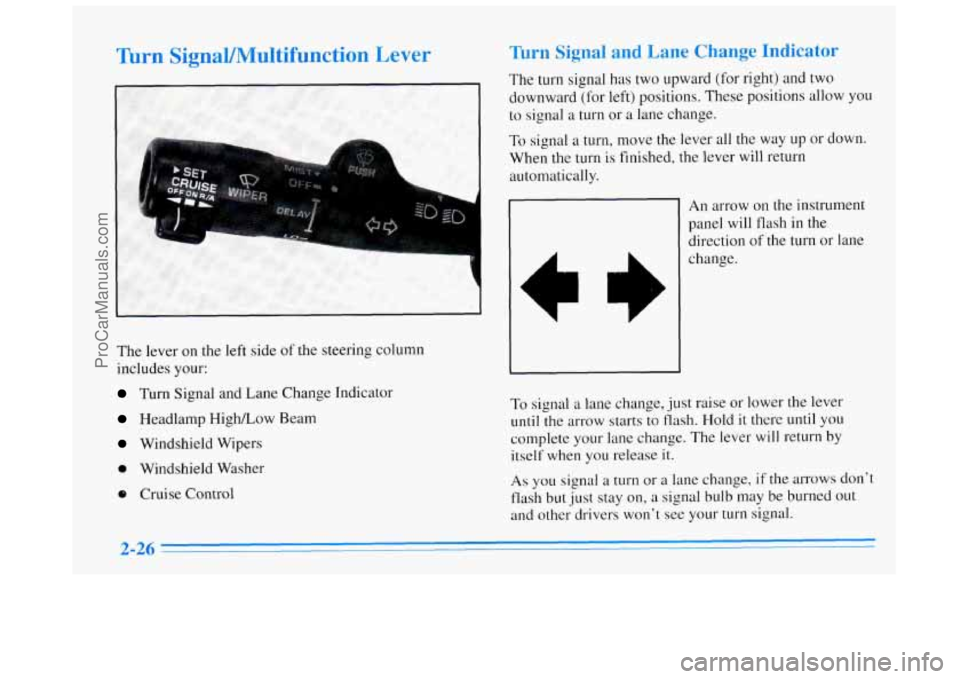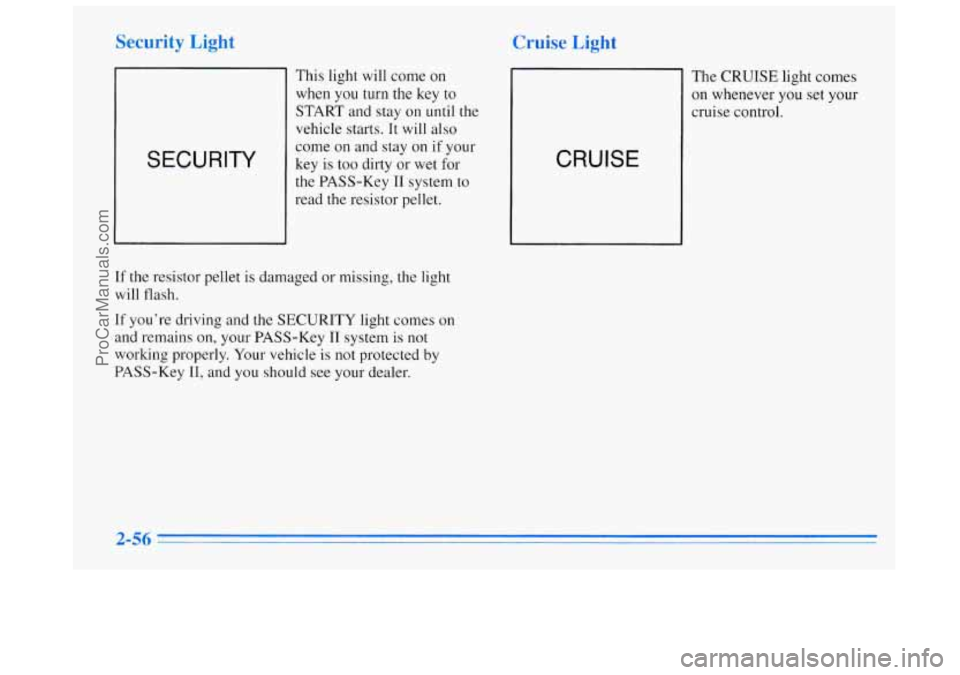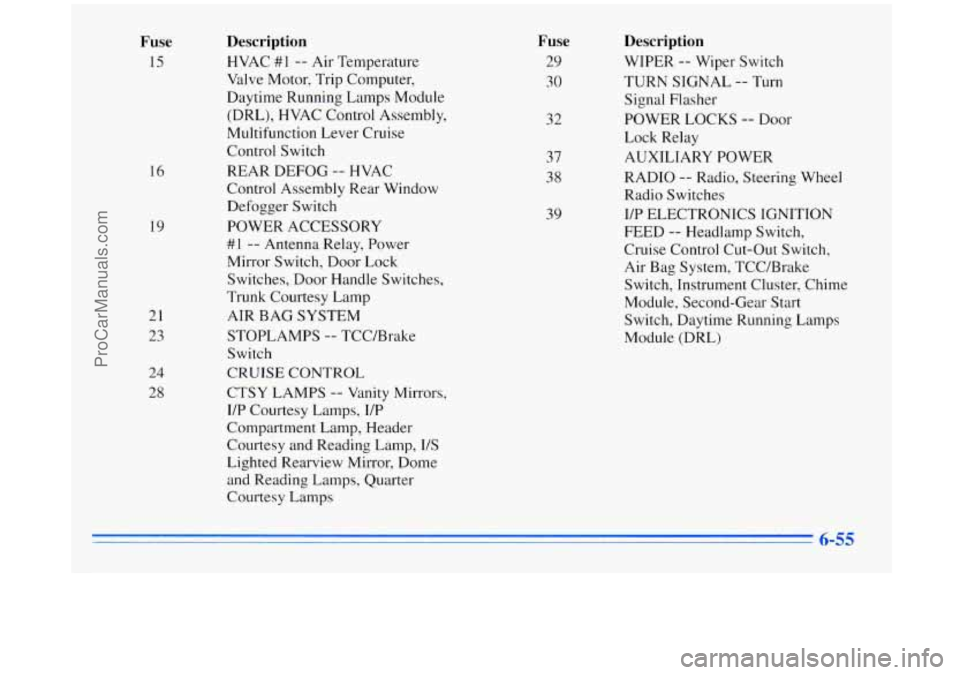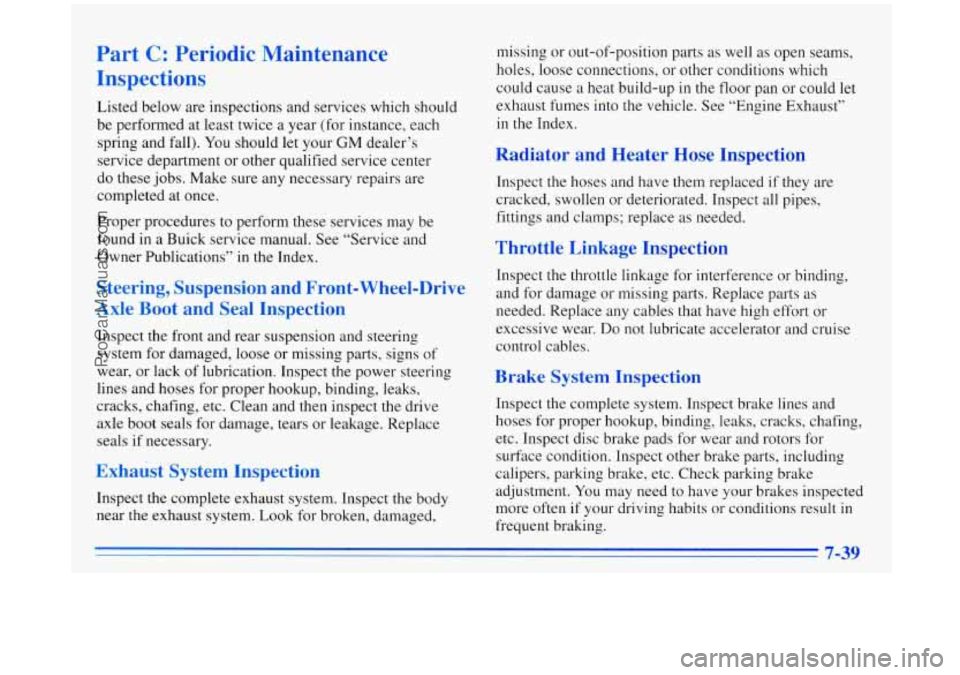1996 BUICK REGAL cruise control
[x] Cancel search: cruise controlPage 92 of 356

Thrn SignaYMultifunction Lever Thm Signal and Lane Change Indicator
The turn signal has two upward (for right) and two
downward (for left) positions. These positions allow you
to signal
a turn or a lane change.
To signal a turn, move the lever all the way up or down.
When the turn is finished, the lever will return
automatically.
The lever on the
left side of the steering column
includes your:
Turn Signal and Lane Change Indicator
Headlamp HigWLow Beam
Windshield Wipers
0 Windshield Washer
e Cruise Control
L
An arrow on the instrument
panel will flash in the
direction of the turn or lane
change.
To signal
a lane change, just raise or lower the lever
until the arrow starts to flash. Hold it there until you
complete your lane change. The lever
will return by
itself when you release it.
As you signal a turn or a lane change, if the arrows don’t
flash but just stay on, a signal bulb may be burned out
and other drivers won’t see your
turn signal.
ProCarManuals.com
Page 95 of 356

Cruise Control
A CAUT1,ON:
Cruise control can be dangerous where you
can’t drive safely
at a steady speed. So,
don’t use your cruise control on winding
roads. or in heavy traffic.
Cruise, control can be dangerous
on
slippery roads. On such roads, fast changes
in tire traction can cause needless wheel
spinning, and you could lose control. .Don’t
use cruise control
on slippery roads.
With cruise control, you can rqaintain a speed of about
25 mph (40 km/h) or more without keeping your foot
on the accelerator.
This can really help on long trips.
Cruise control does not work at speeds below about
25 mph (40 km/h).
When you apply your brakes, the cruise control
shuts
off.
2-29
ProCarManuals.com
Page 96 of 356

Resuming a Set Speed
Suppose you set your cruise control at a desired speed
and then
you apply the brake. This, of course, shuts off
the cruise control. But you don’t need to reset it.
If you leave your cruise control switch on when
you’re not using cruise, you might hit
a button
and
go into cruise when you don’t want to.
You could be startled and even lose control.
Keep the cruise control switch
OFF until you
want to use
it.
1. Move the cruise control switch to ON.
2. Get up to the speed you want.
3. Push in the SET button
at the end of the lever
and release it. The
CRUISE light on the
instrument panel will
come on.
4. Take your foot off the
accelerator pedal.
WA (Resume/Accelerate)
for about half a second.
You’ll go right back up to
your chosen speed and
stay there.
Increasing Speed While Using Cruise Control
There are two ways to go ,to a higher speed:
Use the accelerator pedal to get to the higher speed.
Press the button at the end of the lever, then release
the button and the accelerator pedal. You’ll now
cruise at the higher speed.
0 Move the cruise switch from ON to WA. Hold it
there until you get up to the speed
you want, and
then release
the switch. To increase your speed in
2-30
11
ProCarManuals.com
Page 97 of 356

very small amounts, move the switch to R/A.
Each time you do this, your vehicle will go about
1 mph (1.6 kdh) faster.
The accelerate feature will
only work after you set
the cruise control speed by pushing the
SET button.
Reducing Speed While Using Cruise Control
There are two ways to reduce your speed while using
cruise control:
Push in the SET button until you reach the lower
speed you want,
then release it.
To slow down in very small amounts, push the
SET button for less than half a second. Each time
you do this, you’ll go
1 mph (1.6 kmh) slower.
Passing Another Vehicle While Using Cruise Control
Use the accelerator pedal to increase your speed. When
you take your foot off the pedal, your vehicle will slow
down to the cruise control speed you set earlier.
Using Cruise Control on Hills
How well your cruise control will work on hills depends
upon your speed, load and the steepness
of the hills.
When going up steep hills, you may have to step on the
accelerator pedal to maintain your speed. When going
downhill, you may have to brake or
shift to a lower gear
to keep your speed down.
Of course, applying the brake
takes you out
of cruise control. Many drivers find this to
be too much trouble and don’t use cruise control on
steep hills.
Ending Cruise Control
There are two ways to turn off the cruise control:
Step lightly on the brake pedal; OR
Move the cruise switch to OFF.
Erasing Cruise Speed Memory
When you turn off the cruise control or the ignition, or
shift into PARK (P) or NEUTRAL (N), your cruise
control set speed memory
is erased.
ProCarManuals.com
Page 122 of 356

Security Light
SECURITY
This light will come on
when you turn the key to
START and stay on until the
vehicle starts. It will also
come on and stay on if your
key is too dirty or wet for
the PASS-Key
IT system to
read the resistor pellet.
If the resistor pellet is damaged or missing, the light
will flash.
If you’re driving and the SECURITY light comes on
and remains
on, your PASS-Key TI system is not
working properly. Your vehicle is not protected by
PASS-Key
11, and you should see your dealer.
Cruise Light
The CRUISE light comes
on whenever you set your
cruise control.
CRUISE
2-56
ProCarManuals.com
Page 277 of 356

Fuse
15
16
19
21
23
24
28
Description
HVAC #1 -- Air Temperature
Valve Motor: Trip Computer,
Daytime Running Lamps Module
(DRL), HVAC Control Assembly,
Multifunction Lever Cruise
Control Switch
Control Assembly Rear Window
Defogger Switch
POWER ACCESSORY
#1 -- Antenna Relay, Power
Mirror Switch, Door Lock
Switches,
Door Handle Switches,
Trunk Courtesy Lamp
AIR BAG SYSTEM
STOPLAMPS
-- TCC/Brake
Switch
CRUISE CONTROL
CTSY LAMPS -- Vanity Mirrors,
T/P Courtesy Lamps, I/P
Compartment Lamp, Header
Courtesy and Reading Lamp,
I/S
Lighted Rearview Mirror, Dome
and Reading Lamps, Quarter
Courtesy Lamps
REAR
DEFOG
-- HVAC
Fuse
29
30
32
37
38
39
Description
WIPER -- Wiper Switch
TURN SIGNAL
-- Turn
Signal Flasher
POWER LOCKS
-- Door
Lock Relay
AUXILIARY POWER
RADIO
-- Radio, Steering Wheel
Radio Switches
I/P ELECTRONICS IGNITION
FEED
-- Headlamp Switch,
Cruise Control Cut-Out Switch,
Air Bag System, TCC/Brake
Switch, Instrument Cluster, Chime
Module, Second-Gear Start
Switch, Daytime Running Lamps
Module (DRL)
6-55
ProCarManuals.com
Page 325 of 356

Part C: Periodic Maintenance
Inspections
Listed below are inspections and services which should
be performed at least twice
a year (for instance, each
spring and fall). You should let your GM dealer’s
service department or other qualified service center
do these jobs. Make sure any necessary repairs are
completed at once.
Proper procedures to perform these services may be
found in a Buick service manual. See “Service and
Owner Publications’’ in the Index.
Steering, Suspension and Front- Wheel-Drive
Axle Boot and Seal Inspection
Inspect the front and rear suspension and steering
system for damaged, loose or missing parts, signs of
wear, or lack of lubrication. Inspect the power steering
lines and hoses for proper hookup, binding, leaks,
cracks, chafing, etc. Clean and then inspect
the drive
axle boot seals for damage, tears or leakage. Replace
seals if necessary.
Exhaust System Inspection
mspect the complete exhaust system. Inspect the body
near the exhaust system. Look for broken, damaged, missing
or out-of-position parts as well
as open seams,
holes,
loose connections, or other conditions which
could cause
a heat build-up in the floor pan or could let
exhaust fumes into the vehicle. See “Engine Exhaust”
in the Index.
Radiator and Heater Hose Inspection
Inspect the hoses and have them replaced if they are
cracked? swollen or deteriorated. Inspect
all pipes,
fittings and clamps; replace
as needed.
Throttle Linkage Inspection
Inspect the throttle linkage for interference or binding,
and for damage
or missing parts. Replace parts as
needed. Replace any cables that have high effort or
excessive wear.
Do not lubricate accelerator and cruise
control cables.
Brake System Inspection
Inspect the complete system. Inspect brake lines and
hoses for proper hookup, binding, leaks, cracks, chafing,
etc. Inspect disc brake pads for wear and rotors for
surface condition. Inspect other brake parts, including
calipers, parking brake, etc. Check parking brake
adjustment. You may need to have your brakes inspected
more often if your driving habits or conditions result in
frequent braking.
7-39
ProCarManuals.com
Page 347 of 356

Convex Outside Mirror .......................... 2-37
Coolant
....................................... 6-20
Bleedvalves
................................. 5-19
RecoveryTank
............................... 5-16
Coolant Heater. Engine
.......................... 2- I3
Cooling System
................................ 5- I4
Courtesy Lamps
................................ 2-33
Courtesy Transportation
........................... 8-5
Cruise Control
................................. 2-29
CruiseLight
................................... 2-56
Cupholders
.................................... 2-38
Customer Assistance for Text Telephone Users
......... 8-3
Customer Assistance Information
................... 8- 1
Customer Satisfaction Procedure .................... 8- 1
Damage. Finish ............................... 6-49
Damage. Sheet Metal
............................ 6-48
Daytime Running Lamps
......................... 2-32
Dead Battery
................................... 5-2
Defects. Reporting Safety ......................... 8-7
Defensive Driving ............................... 4- 1
Defogger. Rear Window .......................... 3-6
Defogging
..................................... 3-5
Defrosting
..................................... 3-5
Dimensions, Vehicle
............................ 6-62
Dolby@
B Noise Reduction ................... 3-9, 3- 12
DoorLocks
..................................... 2-3
Driver Position
................................. 1 - 1 1
Driving
City
........................................ 4-17
Defensive
.................................... 4-1
Drunken
..................................... 4-2
Freeway
.................................... 4-18 InaBlizzard
................................. 4-25
In Foreign Countries
........................... 6-4
IntheRain
.................................. 4-15
Night
...................................... 4-13
OnCurves
................................... 4-8
On Grades While Towing
a Trailer ............... 4-34
On Hill and Mountain Roads
.................... 4-21
OnSnowandIce
............................. 4-24
Through Deep Standing Water
................... 4-17
WetRoads
.................................. 4-15
Winter
...................................... 4-23
With a Trailer
................................ 4-33
Drunken Driving
................................ 4-2
Electrical Equipment, Adding
..... 2- I I, 2- 12, 3-24, 6-52
Electrical System
............................... 6-52
Electronic Climate Control
........................ 3-1
Engine
.................................... 6-8, 6-9
Coolant
..................................... 6-20
Coolant Heater
............................... 2-13
Coolant Level Check
.......................... 7-35
Coolant Temperature Gage
..................... 2-51
Coolant Temperature Light
..................... 2-50
Exhaust
..................................... 2-23
Fuse Block (Driver’s Side)
...................... 6-58
Fuse Block (Passenger’s Side)
................... 6-56
Identification
................................ 6-51
OilLevelCheck
.............................. 7-35
Overheating
................................. 5-12
Running While Parked
......................... 2-23
Specifications
................................ 6-62
Starting
Your ........................... 2- 11, 2- 12
0.
ProCarManuals.com